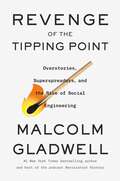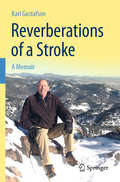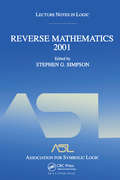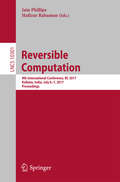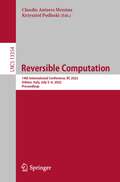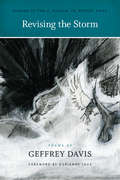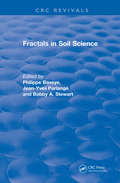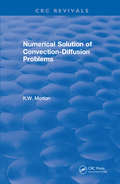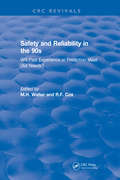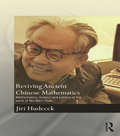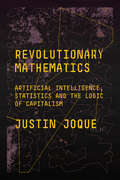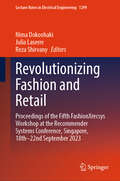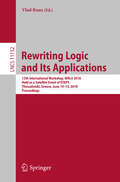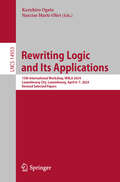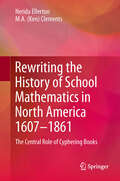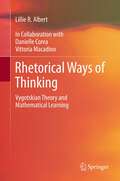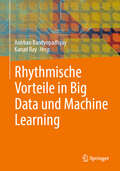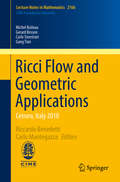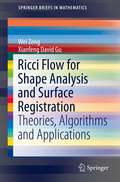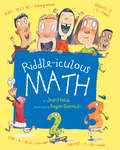- Table View
- List View
Revealed Preference Theory
by Christopher P. Chambers Federico EcheniquePioneered by American economist Paul Samuelson, revealed preference theory is based on the idea that the preferences of consumers are revealed in their purchasing behavior. Researchers in this field have developed complex and sophisticated mathematical models to capture the preferences that are 'revealed' through consumer choice behavior. This study of consumer demand and behavior is closely tied up with econometrics (especially nonparametric econometrics), where testing the validity of different theoretical models is an important aspect of research. The theory of revealed preference has a very long and distinguished tradition in economics, but there was no systematic presentation of the theory until now. This book deals with basic questions in economic theory, such as the relation between theory and data, and studies the situations in which empirical observations are consistent or inconsistent with some of the best known theories in economics.
Revenge of the Tipping Point: Overstories, Superspreaders, and the Rise of Social Engineering
by Malcolm GladwellAN INSTANT NEW YORK TIMES BESTSELLERMost Anticipated in:AARP | Associated Press | Time Magazine | Oprah Daily | Chicago Tribune | Literary Hub | Publishers Weekly | Publishers LunchTwenty-five years after the publication of his groundbreaking first book, Malcolm Gladwell returns with a brand-new volume that reframes the lessons of The Tipping Point in a startling and revealing light. Why is Miami…Miami? What does the heartbreaking fate of the cheetah tell us about the way we raise our children? Why do Ivy League schools care so much about sports? What is the Magic Third, and what does it mean for racial harmony? In this provocative new work, Malcolm Gladwell returns for the first time in twenty-five years to the subject of social epidemics and tipping points, this time with the aim of explaining the dark side of contagious phenomena. Through a series of riveting stories, Gladwell traces the rise of a new and troubling form of social engineering. He takes us to the streets of Los Angeles to meet the world&’s most successful bank robbers, rediscovers a forgotten television show from the 1970s that changed the world, visits the site of a historic experiment on a tiny cul-de-sac in northern California, and offers an alternate history of two of the biggest epidemics of our day: COVID and the opioid crisis. Revenge of the Tipping Point is Gladwell&’s most personal book yet. With his characteristic mix of storytelling and social science, he offers a guide to making sense of the contagions of modern world. It&’s time we took tipping points seriously.
Revenue Implications of Trade Liberalization
by Liam P. Ebrill Reint Gropp Janet Gale StotskyA report from the International Monetary Fund.
Reverberations of a Stroke: A Memoir
by Karl GustafsonIn the early morning hours of Feb. 1, 2016, Karl Gustafson became instinctively aware that something catastrophic was happening inside him. A severe headache that had persisted for days had taken a sudden turn for the worse, and a clear inner voice ordered him to obtain immediate help. With determined effort, he tapped out the digits “9-1-1” on his phone—bringing an ambulance to his door quickly and saving his life. Emergency Room doctors would soon learn that Professor Gustafson, a renowned American mathematician, had suffered a deep brain hemorrhage, and that the situation was dire. By the time his condition was diagnosed, blood had pooled into all four ventricles of Gustafson’s brain and he was comatose. Against all odds and surprising everyone, the author emerged from a near-death state to go on to what he calls his “Second Life”. This is the story of his miraculous journey of recovery, an inspirational tale of grit and determination, in his own words.
Reverse Mathematics 2001: Lecture Notes in Logic 21
by Stephen G. SimpsonReverse Mathematics is a program of research in the foundations of mathematics, motivated by the foundational questions of what are appropriate axioms for mathematics, and what are the logical strengths of particular axioms and particular theorems. The book contains 24 original papers by leading researchers.
Reversibility in Dynamics and Group Theory
by Anthony G. O'Farrell Ian ShortReversibility is a thread woven through many branches of mathematics. It arises in dynamics, in systems that admit a time-reversal symmetry, and in group theory where the reversible group elements are those that are conjugate to their inverses. However, the lack of a lingua franca for discussing reversibility means that researchers who encounter the concept may be unaware of related work in other fields. This text is the first to make reversibility the focus of attention. The authors fix standard notation and terminology, establish the basic common principles, and illustrate the impact of reversibility in such diverse areas as group theory, differential and analytic geometry, number theory, complex analysis and approximation theory. As well as showing connections between different fields, the authors' viewpoint reveals many open questions, making this book ideal for graduate students and researchers. The exposition is accessible to readers at the advanced undergraduate level and above.
Reversible Computation
by Iain Phillips Hafizur RahamanThis book constitutes the refereed proceedings of the 9th International Conference on Reversible Computation, RC 2017, held in Kolkata, India, in July 2017. The 13 full and 5 short papers included in this volume together with one invited paper were carefully reviewed and selected from 47 submissions. The papers are organized in the following topical sections: foundations; reversible circuit synthesis; reversible circuit optimization; testing and fault tolerance; and quantum circuits.
Reversible Computation: 14th International Conference, RC 2022, Urbino, Italy, July 5–6, 2022, Proceedings (Lecture Notes in Computer Science #13354)
by Krzysztof Podlaski Claudio Antares MezzinaThis book constitutes the refereed proceedings of the 14th International Conference on Reversible Computation, RC 2022, which was held in Urbino, Italy, during July 5-6, 2021. The 10 full papers and 6 short papers included in this book were carefully reviewed and selected from 20 submissions. They were organized in topical sections named: Reversible and Quantum Circuits; Applications of quantum Computing; Foundations and Applications.
Review, Practice, & Mastery of Common Core State Standards, Mathematics, Grade 7
by Perfection Learning CorporationNIMAC-sourced textbook
Revising the Storm (A. Poulin, Jr. New Poets of America)
by Geffrey DavisThis debut collection by Cave Canem fellow Geffrey Davis burrows under the surface of gender, addiction, recovery, clumsy love, bitterness, and faith. The tones explored—tender, comic, wry, tragic—interrogate male subjectivity and privilege, as they examine their "embarrassed desires" for familial connection, sexual love, compassion, and repair. Revising the Storm also speaks to the sons and daughters affected by the drug/crack epidemic of the '80s and addresses issues of masculinity and its importance in family.Some nights I hear my father's long romancewith drugs echoed in the skeletal choirof crickets.Geffrey Davis teaches at Penn State University.
Revival: Advances in Soil Science (CRC Press Revivals)
by B.A. Stewart Philippe Baveye Jean-Yves ParlangeThe application of fractals and fractal geometry in soil science has become increasingly important over the last few years. This self-contained and timely book was designed to provide detailed and comprehensive information on the current status of the application of fractal geometry in soil science, and on prospects for its future use. With a detailed and specific introductory chapter, particular attention is paid to comparing and contrasting "fractal" and "fragmentation" concepts. Some uses of fractals, such as to quantify the retention and transport properties of soils, to describe the intricate geometry of pore surfaces and macropore networks, or to elucidate the rooting patterns of various plants, are discussed. Applications of fractals in soil science are both relatively recent and in constant evolution. This book reflects accurately existing trends, by allowing sharp differences among the viewpoints expressed in contributed chapters to be presented to the reader in one self-contained volume.
Revival: Numerical Solution Of Convection-diffusion Problems (1996) (CRC Press Revivals)
by K.W. MortonAccurate modeling of the interaction between convective and diffusive processes is one of the most common challenges in the numerical approximation of partial differential equations. This is partly due to the fact that numerical algorithms, and the techniques used for their analysis, tend to be very different in the two limiting cases of elliptic and hyperbolic equations. Many different ideas and approaches have been proposed in widely differing contexts to resolve the difficulties of exponential fitting, compact differencing, number upwinding, artificial viscosity, streamline diffusion, Petrov-Galerkin and evolution Galerkin being some examples from the main fields of finite difference and finite element methods.The main aim of this volume is to draw together all these ideas and see how they overlap and differ. The reader is provided with a useful and wide ranging source of algorithmic concepts and techniques of analysis. The material presented has been drawn both from theoretically oriented literature on finite differences, finite volume and finite element methods and also from accounts of practical, large-scale computing, particularly in the field of computational fluid dynamics.
Revival: Will past experience or prediction meet our needs? (CRC Press Revivals)
by M.H. Walter R.F. CoxReliability-based design is relatively well established in structural design. Its use is less mature in geotechnical design, but there is a steady progression towards reliability-based design as seen in the inclusion of a new Annex D on "Reliability of Geotechnical Structures" in the third edition of ISO 2394. Reliability-based design can be viewed as a simplified form of risk-based design where different consequences of failure are implicitly covered by the adoption of different target reliability indices. Explicit risk management methodologies are required for large geotechnical systems where soil and loading conditions are too varied to be conveniently slotted into a few reliability classes (typically three) and an associated simple discrete tier of target reliability indices.
Reviving Ancient Chinese Mathematics: Mathematics, History and Politics in the Work of Wu Wen-Tsun (Needham Research Institute Series)
by Jiri HudecekTwentieth-century China has been caught between a desire to increase its wealth and power in line with other advanced nations, which, by implication, means copying their institutions, practices and values, whilst simultaneously seeking to preserve China’s independence and historically formed identity. Over time, Chinese philosophers, writers, artists and politicians have all sought to reconcile these goals and this book shows how this search for a Chinese way penetrated even the most central, least contested area of modernity: science. Reviving Ancient Chinese Mathematics is a study of the life of one of modern China’s most admired scientific figures, the mathematician Wu Wen-Tsun. Negotiating the conflict between progress and tradition, he found a path that not only ensured his political and personal survival, but which also brought him renown as a mathematician of international status who claimed that he stood outside the dominant western tradition of mathematics. Wu Wen-Tsun’s story highlights crucial developments and contradictions in twentieth -century China, the significance of which extends far beyond the field of mathematics. On one hand lies the appeal of radical scientific modernity, "mechanisation" in all its forms, and competitiveness within the international scientific community. On the other is an anxiety to preserve national traditions and make them part of the modernisation project. Moreover, Wu’s intellectual development also reflects the complex relationship between science and Maoist ideology, because his turn to history was powered by his internalisation of certain aspects of Maoist ideology, including its utilitarian philosophy of science. This book traces how Wu managed to combine political success and international scientific eminence, a story that has wider implications for a new century of increasing Chinese activity in the sciences. As such, it will be of great interest to students and scholars of Chinese history, the history of science and the history and philosophy of mathematics.
Revolutionary Mathematics: Artificial Intelligence, Statistics and the Logic of Capitalism
by Justin JoqueTraces the revolution in statistics that gave rise to artificial intelligence and predictive algorithms refiguring contemporary capitalism.Our finances, politics, media, opportunities, information, shopping and knowledge production are mediated through algorithms and their statistical approaches to knowledge; increasingly, these methods form the organizational backbone of contemporary capitalism. Revolutionary Mathematics traces the revolution in statistics and probability that has quietly underwritten the explosion of machine learning, big data and predictive algorithms that now decide many aspects of our lives. Exploring shifts in the philosophical understanding of probability in the late twentieth century, Joque shows how this was not merely a technical change but a wholesale philosophical transformation in the production of knowledge and the extraction of value. This book provides a new and unique perspective on the dangers of allowing artificial intelligence and big data to manage society. It is essential reading for those who want to understand the underlying ideological and philosophical changes that have fueled the rise of algorithms and convinced so many to blindly trust their outputs, reshaping our current political and economic situation.
Revolutionizing Fashion and Retail: Proceedings of the Fifth fashionXrecsys Workshop at the Recommender Systems Conference, Singapore, 18th-22nd September 2023 (Lecture Notes in Electrical Engineering #1299)
by Nima Dokoohaki Reza Shirvany Julia LaserreThis book presents the proceedings from the Fifth Workshop on Recommender Systems in Fashion and Retail (2023), highlighting the latest advances in AI-driven technologies for e-commerce, retail, and fashion. With contributions from leading academic and industry researchers, it explores how AI-powered recommender systems address key challenges and enable innovations in personalization and beauty, size and fit recommendations, and helping brands deliver more tailored and engaging shopping experiences.
Rewriting Logic and Its Applications: 12th International Workshop, Wrla 2018, Held As A Satellite Event Of Etaps, Thessaloniki, Greece, June 14-15, 2018, Proceedings (Lecture Notes in Computer Science #11152)
by Vlad RusuThis book constitutes revised selected papers from the 12th International Workshop on Rewriting Logic and Its Applications, WRLA 2018, held in Thessaloniki, Greece, in June 2018. The 12 full papers presented in this volume were carefully reviewed and selected from 21 submissions. They deal with rewriting, a natural model of computation and an expressive semantic framework for concurrency, parallelism, communication, and interaction, and its applications.
Rewriting Logic and Its Applications: 15th International Workshop, WRLA 2024, Luxembourg City, Luxembourg, April 6–7, 2024, Revised Selected Papers (Lecture Notes in Computer Science #14953)
by Narciso Martí-Oliet Kazuhiro OgataThis book constitutes revised selected papers from the refereed proceedings of the 15th International Workshop on Rewriting Logic and Its Applications, WRLA 2024, held in Luxembourg City, Luxembourg, during April 6–7, 2024. The 11 full papers included in this book were carefully reviewed and selected from 16 submissions. They focus on several topics, e.g., foundations; rewriting as a logical and semantic framework; rewriting languages; verification techniques; applications; and education.
Rewriting the History of School Mathematics in North America 1607-1861
by M. A. Ken Clements Nerida EllertonThe focus of this book is the fundamental influence of the cyphering tradition on mathematics education in North American colleges, schools, and apprenticeship training classes between 1607 and 1861. It is the first book on the history of North American mathematics education to be written from that perspective. The principal data source is a set of 207 handwritten cyphering books that have never previously been subjected to careful historical analysis.
Rhetorical Ways of Thinking
by Lillie R. Albert Danielle Corea Vittoria MacadinoRhetorical Ways of Thinking focuses on how the co-construction of learning models the interpretation of a mathematical situation. It is a comprehensive examination of the role of sociocultural-historical theory developed by Vygotsky. This book puts forward the supposition that the major assumptions of sociocultural-historic theory are essential to understanding the theory's application to mathematical pedagogy, which explores issues relevant to learning and teaching mathematics-in-context, thus providing a valuable practical tool for general mathematics education research. The most important goal, then, is to exemplify the merging of the theory with practice and the subsequent applications to mathematics teaching and learning. This monograph contains five chapters, including a primer to Vygotsky's sociocultural historic theory, three comprehensive empirical studies examining: prospective teachers' perception of mathematics teaching and learning and the practice of scaffolded instruction to assist practicing teachers in developing their understanding of pedagogical content knowledge. Finally, the book concludes with a contextualization of the theory, linking it to best practices in the classroom.
Rhythmische Vorteile in Big Data und Machine Learning
by Kanad Ray Anirban BandyopadhyayDas Buch behandelt verschiedene Aspekte der Biophysik, beginnend mit einem populären Artikel über Neurobiologie und erstreckt sich bis zur Quantenbiologie, um letztendlich das Bewusstsein sowohl von Menschen als auch des Universums zu erforschen. Die Autoren haben neun verschiedene Facetten der natürlichen Intelligenz behandelt, angefangen bei der Entdeckung von Zeitkristallen in der chemischen Biologie bis hin zu den Schwingungen und Resonanzen von Proteinen. Sie haben ein breites Spektrum hierarchischer Kommunikation unter verschiedenen biologischen Systemen abgedeckt. Besonderes Augenmerk wurde darauf gelegt, sicherzustellen, dass der Inhalt selbst für Schülerinnen und Schüler zugänglich ist, wodurch die Biophysik wie ein Lehrbuch erscheint, das die Leser in die Bereiche der Biologie und Physik wie nie zuvor entführt. Die Autoren, die größtenteils erfahrene Akademiker sind, haben klare und einfache Sprache verwendet, um sicherzustellen, dass der Inhalt für alle Leser ansprechend und verständlich ist.
Ricci Flow and Geometric Applications
by Michel Boileau Gerard Besson Carlo Sinestrari Gang Tianriccardo Benedetti Carlo MantegazzaPresenting some impressive recent achievements in differential geometry and topology, this volume focuses on results obtained using techniques based on Ricci flow. These ideas are at the core of the study of differentiable manifolds. Several very important open problems and conjectures come from this area and the techniques described herein are used to face and solve some of them. The book's four chapters are based on lectures given by leading researchers in the field of geometric analysis and low-dimensional geometry/topology, respectively offering an introduction to: the differentiable sphere theorem (G. Besson), the geometrization of 3-manifolds (M. Boileau), the singularities of 3-dimensional Ricci flows (C. Sinestrari), and Kähler-Ricci flow (G. Tian). The lectures will be particularly valuable to young researchers interested in differential manifolds.
Ricci Flow for Shape Analysis and Surface Registration
by Wei Zeng Xianfeng David GuRicci Flow for Shape Analysis and Surface Registration introduces the beautiful and profound Ricci flow theory in a discrete setting. By using basic tools in linear algebra and multivariate calculus, readers can deduce all the major theorems in surface Ricci flow by themselves. The authors adapt the Ricci flow theory to practical computational algorithms, apply Ricci flow for shape analysis and surface registration, and demonstrate the power of Ricci flow in many applications in medical imaging, computer graphics, computer vision and wireless sensor network. Due to minimal pre-requisites, this book is accessible to engineers and medical experts, including educators, researchers, students and industry engineers who have an interest in solving real problems related to shape analysis and surface registration.
Riddle-iculous Math
by Joan Holub Regan Dunnick"What's the number of states in the U.S.A. minus the number of days in the month of May minus the number of paws on a grizzly bear minus the number of legs on the spider in your hair? Spider!?! Eeeek!" The answer to this and other math questions can be found in this funny book of riddles and jokes. Children can learn basic math skills while reading about animal sleepover parties, cafeteria food fights, and a boy who made more than 5 million dollars in one month!
Ridge Functions
by Allan PinkusRidge functions are a rich class of simple multivariate functions which have found applications in a variety of areas. These include partial differential equations (where they are sometimes termed 'plane waves'), computerised tomography, projection pursuit in the analysis of large multivariate data sets, the MLP model in neural networks, Waring's problem over linear forms, and approximation theory. Ridge Functions is the first book devoted to studying them as entities in and of themselves. The author describes their central properties and provides a solid theoretical foundation for researchers working in areas such as approximation or data science. He also includes an extensive bibliography and discusses some of the unresolved questions that may set the course for future research in the field.

